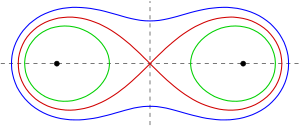
Back Cassini ovaal Afrikaans Авал Касіні Byelorussian Овал на Касини Bulgarian Cassinijev oval BS Oval de Cassini Catalan Cassinische Kurve German Óvalo de Cassini Spanish Cassini-ren obalo Basque Cassinin käyrä Finnish Ovale de Cassini French

In geometry, a Cassini oval is a quartic plane curve defined as the locus of points in the plane such that the product of the distances to two fixed points (foci) is constant. This may be contrasted with an ellipse, for which the sum of the distances is constant, rather than the product. Cassini ovals are the special case of polynomial lemniscates when the polynomial used has degree 2.
Cassini ovals are named after the astronomer Giovanni Domenico Cassini who studied them in the late 17th century.[1] Cassini believed that a planet orbiting around another body traveled on one of these ovals, with the body it orbited around at one focus of the oval.[2] Other names include Cassinian ovals, Cassinian curves and ovals of Cassini.
- ^ Cassini
- ^ Cohen 1962.
© MMXXIII Rich X Search. We shall prevail. All rights reserved. Rich X Search